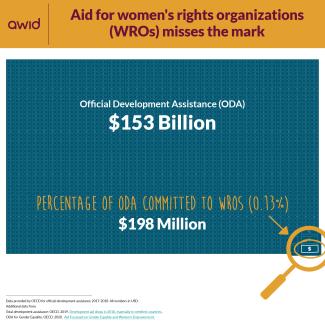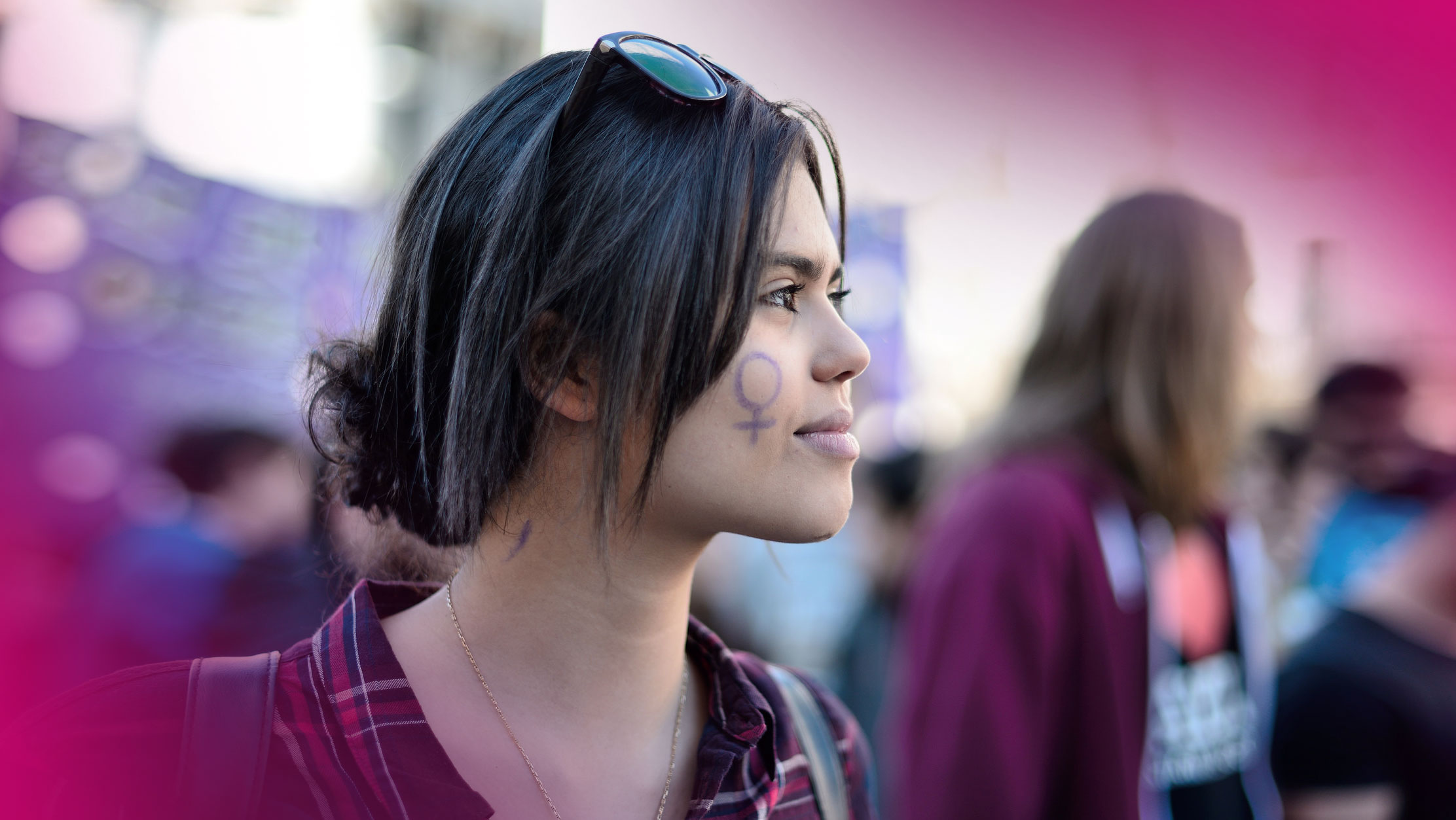This article owes a debt of gratitude to the many partners and consultants who have offered their data and expertise including Kelly Gannon at Global Fund for Women, Anna Koob at Candid, and Jenny Hedman at GenderNet, OECD. The author is also grateful to Kellea Miller, previous RFM Manager, for leading the development of the infographics with Debbie Zamd and Chelsea Very. Additional contributions made by AWID staff include: Kasia Staszewska, Inna Michaeli, and Laila Malik.

Feminist activists and movements have been among the most powerful global voice in demanding fairer policies and a feminist recovery.
The global pandemic has exposed the deadly consequences of decades of disastrous, neoliberal policies.
The obliteration of our basic social protections, in particular the privatisation of health, coupled with the climate crisis, have been devastating for people and our fragile planet. The pandemic has also left the few gains made on gender equality since UN member states committed to the Beijing Platform for Action 25 years ago in serious jeopardy.
In response to these seismic shifts, feminist activists and movements have been among the most powerful global voice in demanding fairer policies and a feminist recovery. For instance, feminists have been leading on the frontlines of the most innovative and needed response to Covid 19, both locally and globally, including pushing back on increased activity by anti-rights actors as well as the massive wealth consolidation by the ultra-rich. Let’s be clear: the need to resource feminist movements in all their diversity has never been greater. However, the new research from Association for Women’s Rights and Development (AWID) shows that women’s rights organizations and feminist movements continue to be systematically under resourced.
Our research analyzed the budgets of feminist organizations using the database of the Global Fund for Women (GFW), one of the leading global feminist funds. Of the 3,739 feminist and women's rights organizations from the Global South that applied for funding with the GFW between 2015 and 2019, almost half of them (48%) operated on median annual budgets of $30,000 or less. Only 6% of the groups have budgets over $300,000 USD; and a mere 2% exceeds $1M USD.
These findings are incredibly sobering, directly impeding the kind of progress necessary to advance gender equality. They also uncover how little has changed since AWID’s last major report in 2013 pointing out that the average budget of women’s rights organizations was only $20,000 USD.

Taking a closer look, we can see the regional differences, donors’ distinct priorities and varying contexts in which movements resource their organizing. While 58% of feminist organizations in Latin America and Caribbean and 57% in Eastern Europe and Central Asia had median budgets of $30,000 USD, this proportion goes down to 47% in Sub-Saharan Africa. Feminists applying for GFW’s funding from Asia Pacific and Middle East and North Africa were in slightly better situations, with respectively 37% and 34% of organizations operating on budgets up to $30,000 USD. The budget sizes of LBQTI, trans, sex workers and young feminist groups are even less. For example, according to ASTRAEA Lesbian Foundation for Justice, the median budget for LBQ groups in 2017 was just $11,713 USD.

This situation is prevailing despite donors’ well-intended commitments to resource gender equality: over 99% of Official Development Assistance (ODA) and foundation grants do not reach women’s rights and feminist movements. In philanthropy, from the massive $1.5T USD in foundation assets and $99B USD in total foundation grants in 2017, $1.14B USD are human rights grants, as per our research analyzing data from Candid, which manages the largest database on global grantmaking. Our analysis indicates that women’s rights grants are only $422.3M USD, equivalent to 0.42% of the total foundation grants in 2017.

Significantly, less than 1% of all gender focused aid is going to women's rights organizations and institutions.
Between 2017-2018, women’s rights organizations received only 0.13% out of the total ODA; and only 0.4% of all gender-focused aid. ODA commitment for women’s rights organizations has increased by only $6M USD, from $192M USD in 2013-2014 to $198M USD in four years. Overall, ODA for gender equality as a primary objective has not changed nearly as much, staying stagnant at 4% of all gender focused aid for nearly 10 years.

Feminist Funding Pales in Comparison to Anti-Feminist and Anti-LGBTQ Funding
More concerning is the fact that these numbers are pale in comparison to the massive funding being driven against the human rights of women and LGBTIQ people, and the advancement of gender justice. Over $280M USD for instance from the Christian right in the US fund activities that collude with Russia and other anti-rights actors at multilateral spaces like the UN. They are effectively making devastating inroads to roll back human rights, gender, and sexual and reproductive freedom and bodily autonomy. At the national and regional level, extensive financial resources fuel efforts to push anti-feminist and anti-LGBTQI legislation.
In addition to the increased work of anti-rights actors, further wealth consolidation by the ultra-rich is threatening the human rights of women and LGBTQI, feminist movements and gender justice efforts. The pandemic has triggered an unprecedented economic crisis, pushing many more people into poverty while the wealth of billionaires see their net worth increase by half a trillion dollars. Meanwhile, taxpayers subsidize the poverty wages of the many workers of the companies owned by these billionaires. Importantly, with asymmetries of power between countries and regions, there is a systematic plundering of capital and wealth from some of the poorest countries, resources desperately needed to fund life saving services, not least gender justice related. In these times of unprecedented economic crises, programs targeting gender equity, women and girls rights get defunded while their needs drastically increase.
Tax evasion and neo-colonial theft of resources from the Global South are ubiquitous.
For example, relying on tax evasion, corruption, and illicit transfers of goods, foreign companies (and countries) move African resources and private wealth off African soil. Over $427B USD in tax are hauled off each year by international corporations, wealthy individuals and groups. Higher income countries are responsible for 98 percent of countries’ tax losses, costing countries over $419B USD in lost tax every year. Lower income countries are responsible for merely 2 percent, costing countries over $8B USD in lost tax every year. Imagine if these resources are actually available and used directly to fund the many broken social protection systems, relied heavily by women and girls.
2021 is a critical year to assess, critique, and re-invigorate the resourcing landscape for advancing gender justice and women’s human rights. While more and better funding is needed urgently, we must also shine a light on how funders move their money and where and who it is actually reaching. A recent report by Mama Cash and AWID, in the context of our Count Me In! Partnership, showcases real-world examples on how donors can overcome their institutional challenges, and move ambitious resources directly to feminist movements, particularly in the Global South.
The time is now for transformative resourcing strategies to directly reach frontline women’s rights and feminist movements who are faced with overwhelming challenges brought also by a unsustainable global economic system. Feminist and women’s rights activists have been a critical resistance and a strong bulwark against rising anti-democratic, fascist and fundamentalist actors around the globe.
This article was originally published by Ms. magazine
